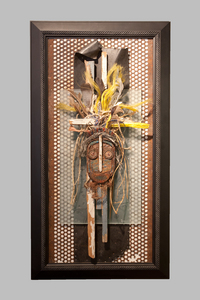

Inspired by African fetish objects and the craft traditions of Tennessee, Sammie Nicely finds mask making to be a direct source of empowerment. (Jeffrey Stoner Photography)
Sammie Nicely is a contemporary folk artist who works in sculpture, ceramics and mixed media. Recently he began making face jugs in collaboration with local potter Phillip Shavell, but Nicely is perhaps best known for his pit-fired clay masks that fuse African and Southern Appalachian art traditions. Pit-firing was historically practiced in African, Native American and Japanese cultures.
Nicely's masks are modern interpretations embellished with natural and recycled materials. Once the firing process is complete, he adds buttons, bottle caps, metal objects, costume jewelry and trinkets he finds in antique and second-hand stores, flea markets, and on the streets. By incorporating these objects, Nicely taps into the aesthetics of popular culture.
Inspired by African fetish objects and the craft traditions of Tennessee, Nicely finds mask making to be a direct source of empowerment. Through his creative process, he says he becomes more aware of his African heritage as well as his experience as an African-American male.
"Making masks and face jugs is a look back at my heritage and African culture," says Nicely. "I pull things from that and make them my own. I try to use my own language, my own voice."
Nicely has traced his genealogical history back to his African roots. His maternal grandmother was a slave at three years old. The property his family owns in Morristown, Tenn. was purchased after his great-grandparents were freed from slavery.
Nicely attended all-black schools for 10 years and an integrated high school for two years, followed by Morristown Junior College, an all-black school, and finally Middle Tennessee State University. While going to MTSU, he says, "I went through the black movement, finding my identity through dress and hair and learning to accept who I am. As an artist at a predominantly white institution, I started wondering about my roots. At that time, there were no classes offered in African art or art history, just European history, so my professor in art history suggested that I do my term paper on African art.
"A friend living in [Washington,] D.C. had been collecting African art since we were in high school. I started looking at his collection and going to museums to look at African art, and trying to relate that to my life and my culture and heritage. That's when I became fascinated with masks and the use of natural materials."
Nicely now lives in Atlanta, Ga., but his name is well known throughout Northeast Tennessee, Southwest Virginia and Western North Carolina where he has displayed his work and taught art for more than 30 years. He frequently exhibits his artworks at the Johnson City Area Arts Council Gallery, Nelson Fine Art Center, East Tennessee State University (ETSU), William King Museum in Abingdon, and elsewhere.
Last year his work was featured in "Appalachian Then and Now," a special exhibit for the inaugural Mildred Haun Conference: A Celebration of Appalachian Literature, Culture & Scholarship at Walters State Community College in Morristown. For the Rose Center in Morristown, Nicely curated the "From Africa to Appalachia" art exhibition and developed hands-on elementary art projects. Last year, Nicely was the juror for ETSU's 26th annual "Positive/Negative" national juried art exhibition.
Nicely co-founded the Africa to Appalachia Foundation in Morristown "to bring more awareness of African culture to the region through visual and performing arts. We've brought in African dance companies, musicians, visual artists, puppeteers, and more," says Nicely, who curates art exhibits for the program.
He created transportation-related public art for the transit station in Knoxville, Tenn. In 1996, he was commissioned by the Olympics Public Art Committee to create "Out of Many, One" at Hartsfield International Airport in Atlanta, Ga. The permanent installation features 20 masks made out of ceramic tile, hand-built ceramic and "found" objects.
Now through March 17, Nicely's artwork is on display in "Common Ground: Affrilachia! Where I'm From" at the August Wilson Center for African American Culture in Pittsburgh, Pa. The exhibit features nearly 50 works in a broad range of areas and styles - including traditional crafts, realism, abstraction, conceptual, visionary and folk art - by artists from throughout Appalachia.
Nicely received a Tennessee Arts Commission Fellowship for craft and advised an installation on the University of Tennessee-Knoxville campus about the cultural progression of African-American families. He studied at the Arrowmont School of Arts and Crafts in Gatlinburg, Tenn., and taught at the Penland School of Arts and Crafts in Penland, N.C. A retrospective of Nicely's work was on display in 2010 at the University of North Carolina-Wilmington.
READ ON:
Jasper McGruder - "Growing up African-American gives you a special perspective."